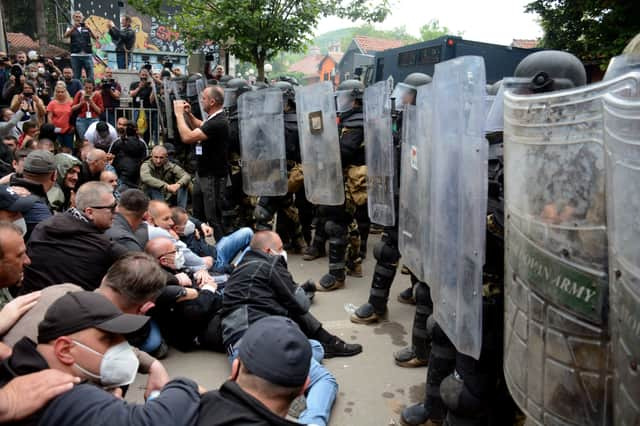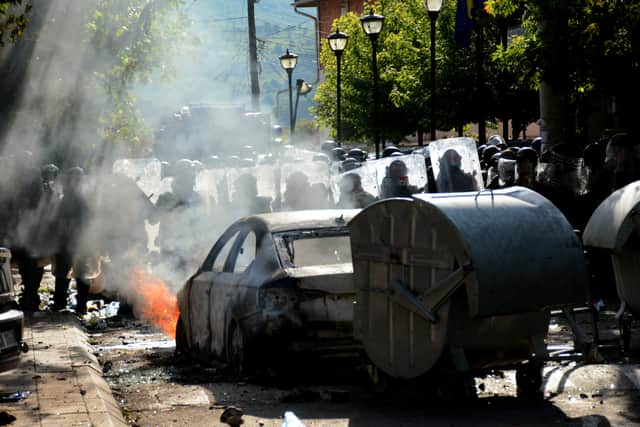Kosovo: protests explained as NATO to send 700 more peacekeepers - what is the history with Serbia?


Ethnic Serbian protesters in Kosovo have clashed with NATO peacekeepers, with the security alliance planning to send in 700 extra troops to squash violence in the country.
Demonstrations had broken out following the elections in Kosovo last month. NATO peacekeepers were sent in to dampen the protests after ethnic Serbian citizens attempted to storm a government building in Zvecan against the results of the election.
Advertisement
Hide AdAdvertisement
Hide AdSerbian tennis player Novak Djokovic waded into the diplomatic situation after making a statement during the French Open. He wrote the message "Kosovo is the heart of Serbia. Stop violence” on the camera after winning his match against Aleksandar Kovacevic on Monday (29 May), and posted an image of the statement on his Instagram page shortly after.
The history between Kosovo and Serbia is deep-routed and dates back centuries. Tensions have remained high between the two states after Kosovo gained its sovereignty from its neighbours.
Why are there protests in Kosovo?
Ethnic Serbian protesters demonstrated against new administrations after ethnically Albanian leaders won in last month's elections. The election was boycotted in northern Kosovo by Serbs who desire to be reunited with Belgrade.
This boycott meant that ethnic Albanian representatives were elected to power in local councils despite a turnout of less than 3.5%. Protesters have since denounced the new administrations and called for their removal.
Advertisement
Hide AdAdvertisement
Hide AdAngry ethnic Serbian citizens attempted to block the elected officials from entering government buildings and also clashed with local Kosovo police during demonstrations.
NATO peacekeepers were dispatched to help curb violence. Initially 30 troops - 11 from Italy and 19 from Hungary - were dispatched but now more than 700 troops will be sent in as demonstrations continue.
Serbian president Aleksandar Vucic said that Kosovo prime minister Albin Kurti "alone is responsible" for the situation.


The decision to allow the election results to be confirmed despite the incredibly low turnout has been criticised by the US and its allies. U.S. Secretary of State Antony Blinken released a statement in which he described the move as having "sharply and unnecessarily escalated tensions" between the two states.
Advertisement
Hide AdAdvertisement
Hide AdHe added: “These actions have sharply and unnecessarily escalated tensions, undermining our efforts to help normalize relations between Kosovo and Serbia and will have consequences for our bilateral relations with Kosovo. We call on Prime Minister Albin Kurti to reverse course and on all sides to refrain from any further actions that will inflame tensions and promote conflict.”
What is the history between Kosovo and Serbia?
Kosovo and Serbia's history dates back centuries. Amid the Balkan War with the Ottoman Empire in 1913, Kosovo was ceded to Serbia and Montenegro
The cultural make-up is mostly ethnic Albanians who follow Islam as a religion, while the majority of Serbia are Christian Orthodox. This clash has led to disputes between ethnic Albanian and ethnic Serbians over territory.
Kosovo was given autonomy in 1974 as part of Yugoslavia. This was ratified by the Yugoslav Constitution.
Advertisement
Hide AdAdvertisement
Hide AdIn 1981, ethnic Albanians sought sovereignty of the region, with widespread riots breaking out over the issue. However, in 1989, Serbian president and later the Yugoslavian president, Slobodan Milosevic, abolished the autonomous status Kosovo had previously gained, with direct rule from Belgrade introduced.
The Kosovo War broke out in the late 1990s as Kosovo groups, including the Kosovo Liberation Army (KLA), pushed for independence as a sovereign state. Milosevic, who would later be charged with war crimes for his role in the ethnic cleansing of Croats, Balkans and Albanians, attempted to push back demonstrators and the ensuing violence killed 13,000 people.
This contradicted a proposed NATO peace agreement created in 1998 which essentially granted Kosovo freedom from Belgrade's direct rule. The security alliance facilitated the bombing of Yugoslavia in 1999 after the country refused to sign the agreement.
The bombing lasted a total of 78 days before Milosevic conceded to NATO terms. In 1999, Kosovo was given the temporary control of a United Nations Interim Administration Mission with NATO peacekeepers supporting the running.
Advertisement
Hide AdAdvertisement
Hide AdAlmost ten years later in 2008, Kosovo gained full independence from Serbia. However, while it has been recognised as a sovereign state by 101 UN members, Serbia has not recognised its full sovereignty, instead referring to Kosovo as 'Autonomous Province of Kosovo and Metohija'.
Tensions have remained high between Serbia and Kosovo in recent years. In December 2022, Serbian security forces were placed at "full combat readiness" on the border between the two neighbouring countries, with Serbian president Aleksandar Vucic stating that the country would be willing to carry out measures to "to protect the Serbian people in Kosovo".
Comment Guidelines
National World encourages reader discussion on our stories. User feedback, insights and back-and-forth exchanges add a rich layer of context to reporting. Please review our Community Guidelines before commenting.
